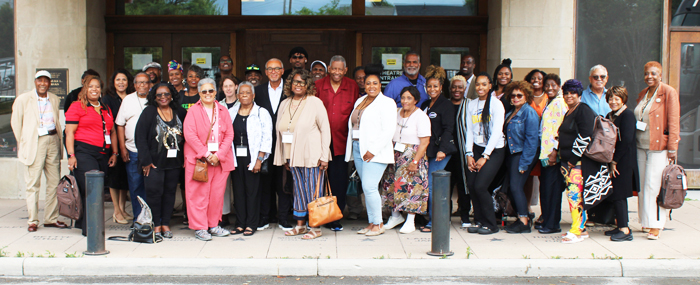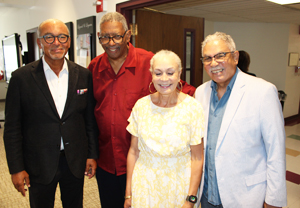
By Fletcher Word
The Truth Editor
The African American Legacy Project, under the guidance of Director Robert Smith, organized a bus trip on Wednesday, July 10, to Columbus for about 40 Toledoans. The travelers were able to get a glimpse of the capital city’s resurrected King Lincoln District and to gain some insights from those in Columbus who had been instrumental in that district’s revitalization over the past three-plus decades.
The travelers included a number of long-time Dorr Street area residents along with elected officials Ohio state Senator Paula Hicks Hudson, Lucas County Commissioner Anita Lopez, Toledo City Councilwomen Cerssandra McPherson and Brittany Jones. Three other city council members sent representatives.
Media presence included The Blade, The Truth and Rick and Debra Hogan of The Juice 107.3.
The Toledo visitors were treated to a day of hospitality, tours and, most importantly, information from Columbus leaders who led the turnaround in the Columbus neighborhood – Larry James, an attorney who got the King Arts Complex going in the late 1980s; former Mayor Michael Coleman who led the effort to reconstruct and rehab the Lincoln Theatre and Boyce Safford who served as Coleman’s director of development and was the go-to guy for the Lincoln Theatre project.
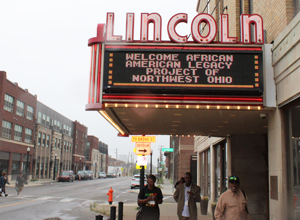 The Lincoln Theatre and the King Arts Complex are the main development projects in what is Columbus’ King-Lincoln District – a district, said Coleman that once held a population, primarily African American, of 64,000. In the 1960’s city and state leaders decided that the highway system – Interstates 71 and 70 – should be constructed through the city and cut off the African American neighborhood from the predominantly white and downtown areas.
The Lincoln Theatre and the King Arts Complex are the main development projects in what is Columbus’ King-Lincoln District – a district, said Coleman that once held a population, primarily African American, of 64,000. In the 1960’s city and state leaders decided that the highway system – Interstates 71 and 70 – should be constructed through the city and cut off the African American neighborhood from the predominantly white and downtown areas.
The plan to devastate the Black neighborhood worked all too well. When Coleman took office in 1999 – the first Black mayor of Columbus – that African American enclave’s population had dropped to 16,000 and the area reeked of “vacant lots, broken buildings and higher crime,” he told his Toledo visitors.
At least there was the Kings Art Complex and a decrepit, shuttered Lincoln Theatre around which to rebuild the district.
Larry James, an attorney, had started the King Arts Complex in 1987 with “small baby steps,” he said. He and his team launched community block parties and eventually brought together, on the advice of Les Wexner, a group of Black community and business leaders to gauge the commitment the community would have for the project.
Wexner is the founder and chairman of retail giants such as The Limited which expanded to include Victoria’s Secret, Pink, Bath & Body Works, The White Barn Candle Company, among others. A billionaire, he is also a major contributor to numerous Columbus and Ohio enterprises and community causes.
At a meeting of the community leaders, James reached out for their support. “If we don’t take the lead, the rest of the community won’t follow,” he recalled to the Toledoans at last week’s event. “The Black folks in the private community have to step up.”
They stepped up at that meeting to launch the development of the Kings Art Complex and wrote checks to the tune of $124,000. Wexner also stepped up and wrote a check of matching funds – $124,000.
“We knew we had to write the checks,” recalled James. Writing checks, however, was only the beginning. There would be lots of hard work ahead to turn the former Garfield Elementary School into the King Arts Complex. “Sometimes you have to have the integrity to believe your hard work will make it happen.”
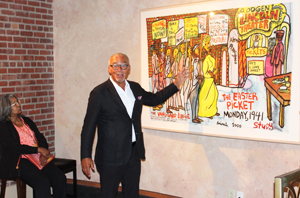
That hard work, begun in 1987, progressed through the decades as the neighborhood became a site for economic development, as new houses were built and old ones renovated, as the renovated Lincoln Theatre (completed in 2009) became an integral part of the neighborhood and as a Black-owned bank – the Adelphi – would open in recent years. In 2018 the Harlem Renaissance’s 100th anniversary was celebrated in the district and, as the New York Times reported, the Columbus celebration was markedly better than the New York City one.
About a dozen years after the Kings Art Complex opened, Michael Coleman was sworn in for his first of four terms as Columbus mayor. He was the first African American mayor of Ohio’s capital city and would eventually become the longest serving mayor.
The plight of the predominantly Black community of the city, bounded by I-71 on the west, Atcheson Street on the north, 20th Street on the east and East Broad Street on the south, troubled him greatly. “It became a constant thing in my mind, in my heart, in my soul, he recounted last week.
He turned to Boyce Safford, deputy chief of staff and, later, director of the Department of Development, to work closely with him in reworking the district. And then, one day, he wandered into the once-great Lincoln Theatre.
The Lincoln Theatre sits in the heart of what was once a solidly Black community, the community where virtually all of Columbus Black residents lived for decades during legal segregation. “Before desegregation Lincoln was the only theatre that Blacks could attend,” said Coleman of the pre-civil rights days.
It was the entertainment focus, and more, of the Black community for decades. Virtually every Black musician coming through town had played there. Sammy Davis Jr., at the age of three in 1928, began his professional performing career there. During the 1960s, the civil rights meetings during the 1960s in Columbus were held there.
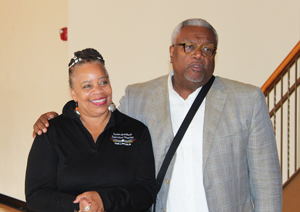
But when Mayor Coleman saw it, during his first term in office, some 30 years after it had been closed, it was slated to be demolished. As he recalls, the theatre was in shambles – holes in the walls and ceilings, no floor left. However, he saw the possibility of restoring the once-grand entertainment facility.
“There were dirt floors, no stage, no ceiling, an empty shell … but the voices and spirit of Black folks were there,” said Coleman. The theatre was owned by a “slumlord.” Not just any slumlord but one who “hated me and I hated him.”
The mayor brought in police and fire officers, established the building as part of the safety forces headquarters and announced during his 2004 “state of the city” address of his intentions to revive the building.
The mayor and Safford got busy forming partnerships with state and county governments, with the private sector, forming a plan, sharing their vision and ultimately putting together about $24-25 million to restore the facility – city funds, private funds, other government’s funds. In 2009, the new Lincoln Theatre opened and “thousands of people came to see it remembering what it was like when they were kids.”
In 2012, Columbus City Council voted to create the Columbus Next Generation (CNG) Corporation, a private, non-profit real estate development group focusing on the city’s neighborhoods – Linden, the Near East Side, south side, Parsons Avenue and Franklinton. The vision is to take underutilized property in the neighborhoods and create opportunities for commercial real estate.
Out of this group has come the formation in the Near East Side (which includes the King Lincoln neighborhood) of the Adelphi Savings and Loan, a building that also includes a 130-unit apartment complex with retail space, and that is in addition to the with other retail and residential developments in the area.
Coleman offered his formula for success to his Toledo visitors.
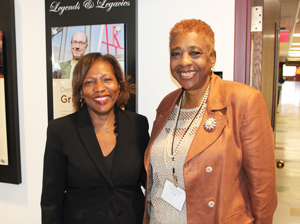
“Three things – number one – leadership; number two – a vision and number three capacity to execute the vision – the organizational capacity and the financial capacity.”
Columbus was able to salvage neighborhood structures as part of the vision to resurrect that part of the city. In Toledo, all those structures along Dorr Street were razed.
Given the task in Toledo of working with a virtually blank slate, those on the trip emphasized the even greater need in the Glass City of having a clear unified vision.
“It was a good way to find out what will work and what doesn’t work,” said Councilwoman Jones. The next step “is to get more of the community on board looking at what we have now and what can we do. We have to look at how to bring up more economic development.”
“This was a good opportunity for folks to see what is possible if they all come together,” said Sen. Hicks Hudson. “There has to be a plan, we have to create an organic plan and identify what our purpose is … economic development is a combination of different things, we have pockets on Dorr Street, but not yet cohesive.”
“Micheal Coleman made it happen,” said Commissioner Lopez. “He made it a priority and it’s been a 22-year experience that is just coming to fruition. But are we as passionate, can we have something similar? Is this what we want and can we have the political and financial support in the community – are we unified with support?”
The next step for The AALP is to hear the voices of the men and women who visited the King-Lincoln District and give them an opportunity to share their thoughts and experiences about their recent Columbus visit. This meeting will serve to help frame the future direction of subsequent series of community meetings and engagements including a presentation to area ministers by Rev. Keith Troy, pastor of New Salem Baptist Church Columbus, Ohio.
Rev. Troy’s church sits in the middle of the King Lincoln District, Rev. Troy, nephew of the late J. Frank Troy, will visit Toledo in the fall to discuss the impact of the King-Lincoln District on the churches, residents, people and businesses in the King-Lincoln District.
The Legacy Project will offer a series of community engagements to seek input and share information in an effort to galvanize support across the entire community for the proposed Dorr Street Historic District.
